Arts & Sciences History
A Meet our first graduates
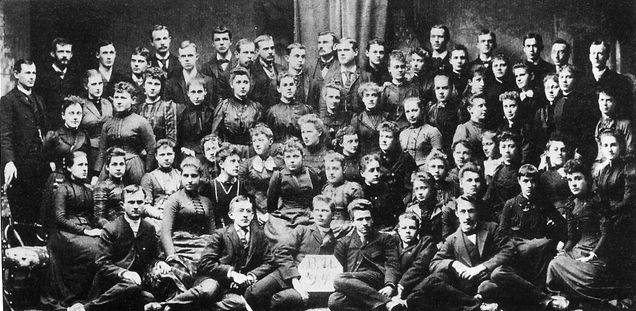
The College of Liberal Arts Class of 1877.
Hear from our first president
Read President Warren’s Speech on “The Essential Idea of a College of Liberal Arts”
A Look Back Through Time
1873-1923
-
1873
The College of Liberal Arts is founded. Reverend John W. Lindsay, lecturer of Roman literature, is appointed as the first dean. The new college is housed in two refurbished townhouses across from the State House at 18-20 Beacon Street. The old Granary Burying Ground rests in the rear. A decade later, one of the townhouses is remodeled into the dignified “Claflin Building,” which still exists today.
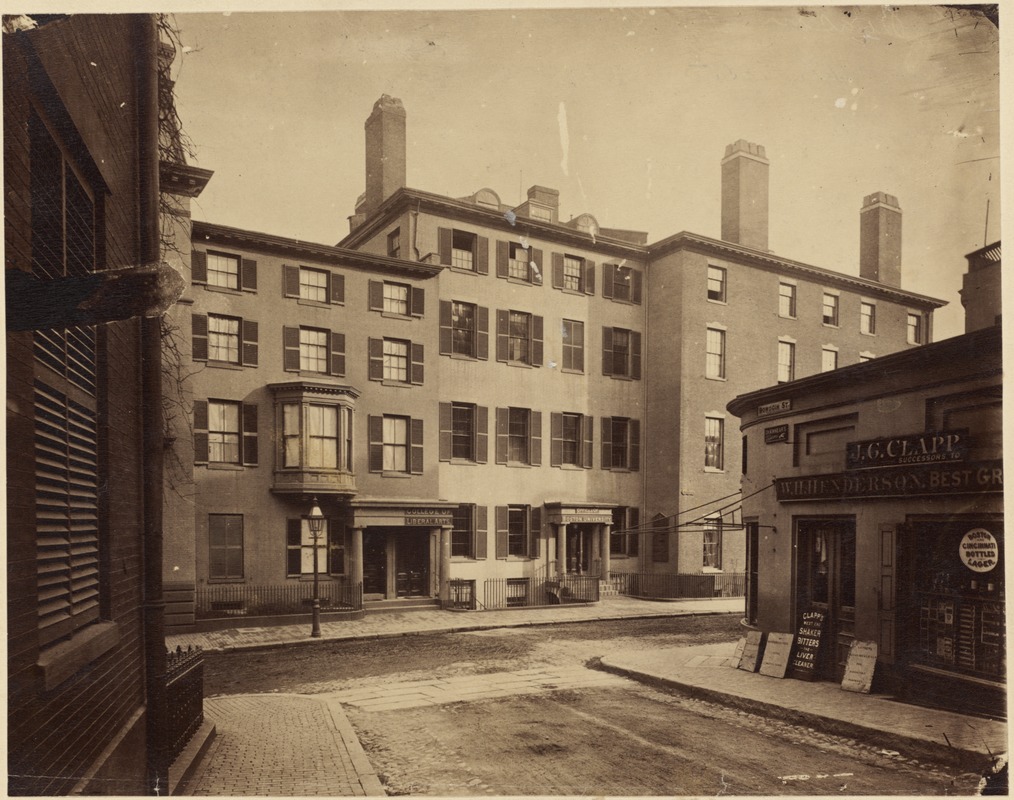
-
1873
Twenty-two students (eight women and fourteen men) enroll in the first semester of CLA. They hail from lower to middle-class backgrounds across New England, commute to campus each day by horse-drawn street cars, and attend daily chapel services. Many take a working lunch to help pay their $60 tuition fee. In their first two years, they take required courses in Classical History, Rhetoric, and Mathematics. They also take four required language courses (Greek, Latin, German, and French).
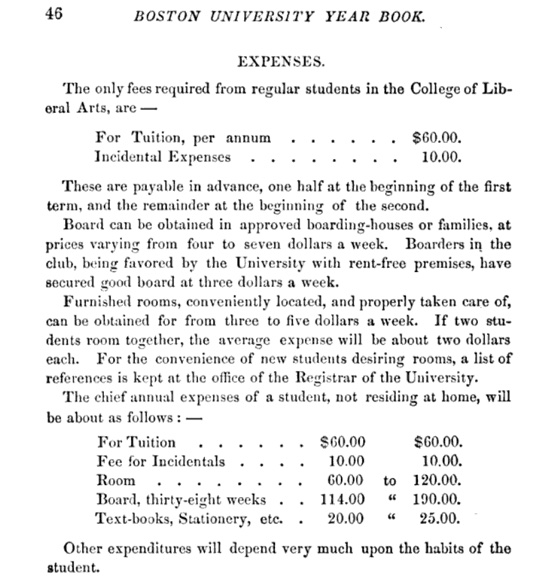
-
1873
Sara Emerson is the first woman to recite in class at CLA. After graduating, she goes on to earn a PhD from Yale and later serves on the faculty at Wellesley College.

-
1873–79
The School of Oratory, housed in the same building as CLA and sharing some of the same faculty, includes faculty member “Prof. A. Graham Bell,” who teaches Culture of the Speaking Voice. A paid year’s leave allows Prof. Bell to perfect a medium for transmission of speech over wires. The first public transmission is from that building to the Atheneum Reading Room.

-
1874
Elizabeth Stuart Phelps, a notable Reconstruction-era novelist, becomes the first woman to teach for CLA. She serves as a part-time Lecturer of Representative Modern Fiction.

-
1874
The School of All Sciences (later, Graduate School) opens. John W. Lindsay is appointed acting dean. (Mark Hopkins, ex-President of Williams College, was offered the role, but was unable to accept.)

-
1876
Borden Parker Bowne, at the age of twenty-nine, is hired to fill the esteemed position of Chair of Philosophy. He becomes a preeminent philosopher and the progenitor of an influential school of thought called Personalism.
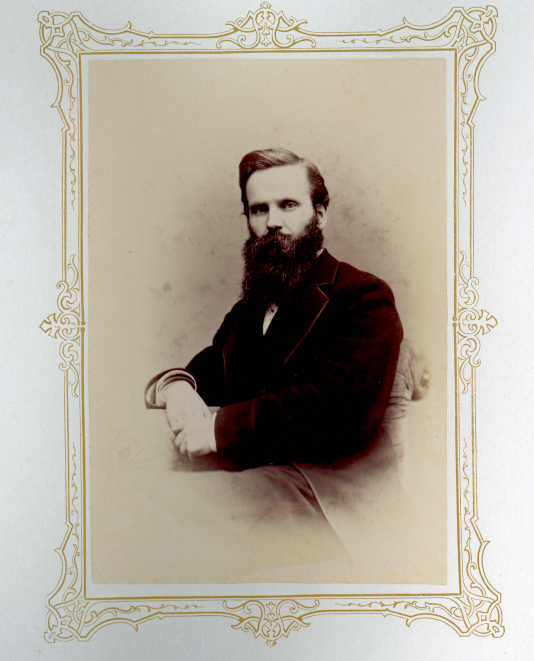
-
1877
Thirty-two students earn bachelor’s degrees from CLA in its first class of graduates, including some transfer students who grafted onto that first cohort in later years. Many go on to graduate school and later enter the Methodist Ministry. Five became teachers, seven entered business, and there was one judge, one doctor, one editor, one accountant, and one farmer.
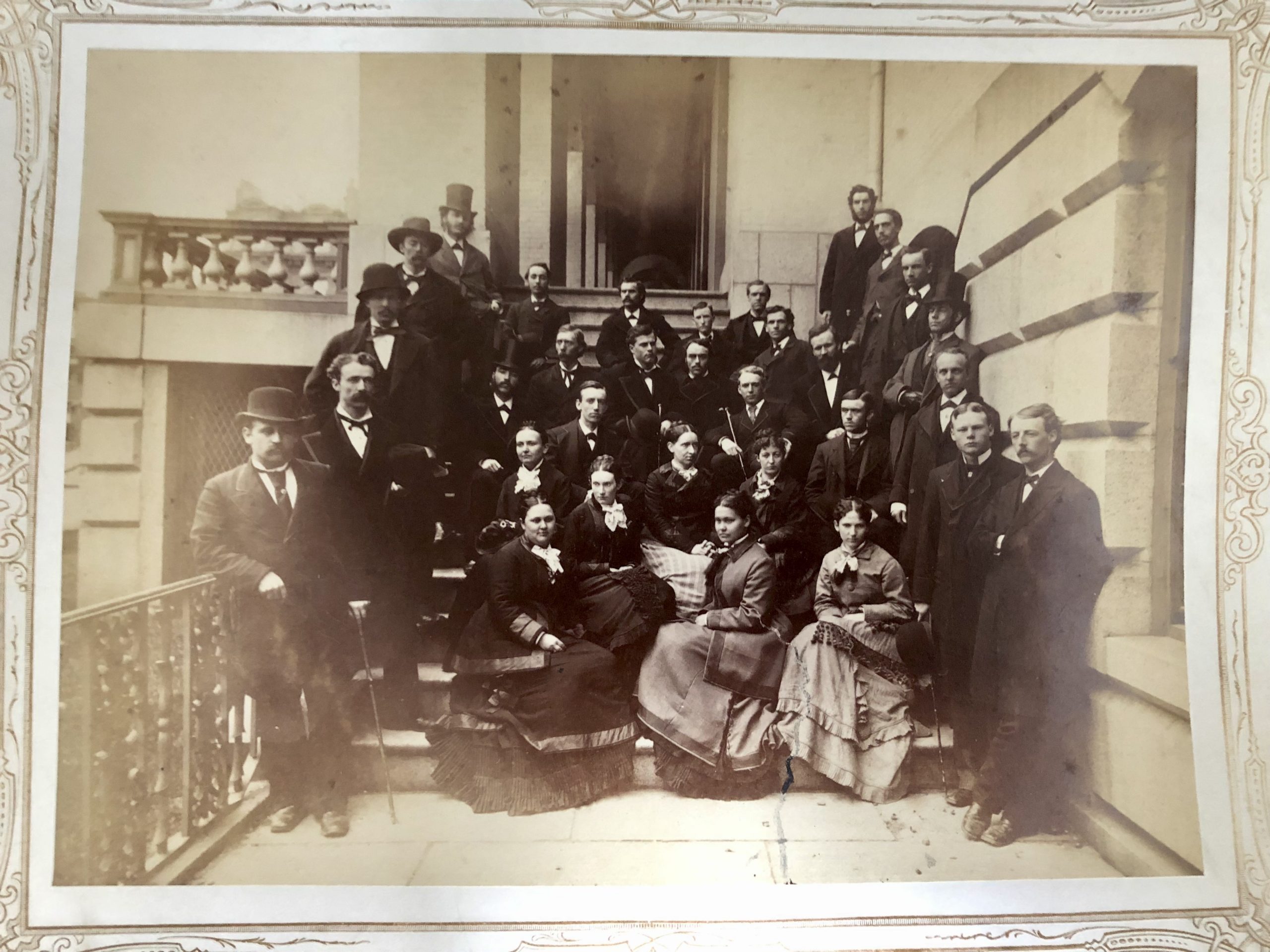
-
1877
Helen Magill, who was the only female in her class at Boston Public Latin school, earns her PhD in Greek. She is the first woman to earn a doctorate in the United States. She and James Barclay Hall are the first two students to graduate with PhDs from Boston University.

-
1880
Marion Talbot graduates with her Bachelor of Arts degree. Talbot would organize the Associate of Collegiate Alumnae, now known as the America Association of Collegiate Women. She would go on to serve in a longstanding role as both the Dean of Women and the faculty head of the Department of Household Administration for the University of Chicago.

-
1881
Alice Stone Blackwell, daughter of famous suffragist Lucy Stone, graduates from the College of Liberal Arts with honors. While a student, she served as class president and was a member of Phi Beta Kappa. She was an ardent suffragist and wrote many tracts in support of the movement. Decades later, she served as a University Trustee, and in 1945, BU awarded her with an honorary degree.
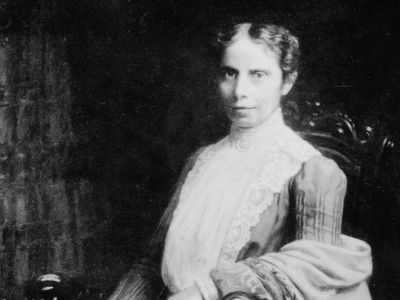
-
1882
By the spring term of 1882, enrollment in CLA grew from the original 22 students to a total of 144 students. Having outgrown 20 Beacon Street, the College used proceeds from the Isaac Rich bequest to purchase the vacant First Baptist Church at 12 Somerset Street. The church’s 219-foot spire was removed, and the façade was renovated in the Renaissance style. CLA moved into 12 Somerset Street, renamed as Jacob Sleeper Hall, in time for the fall term.
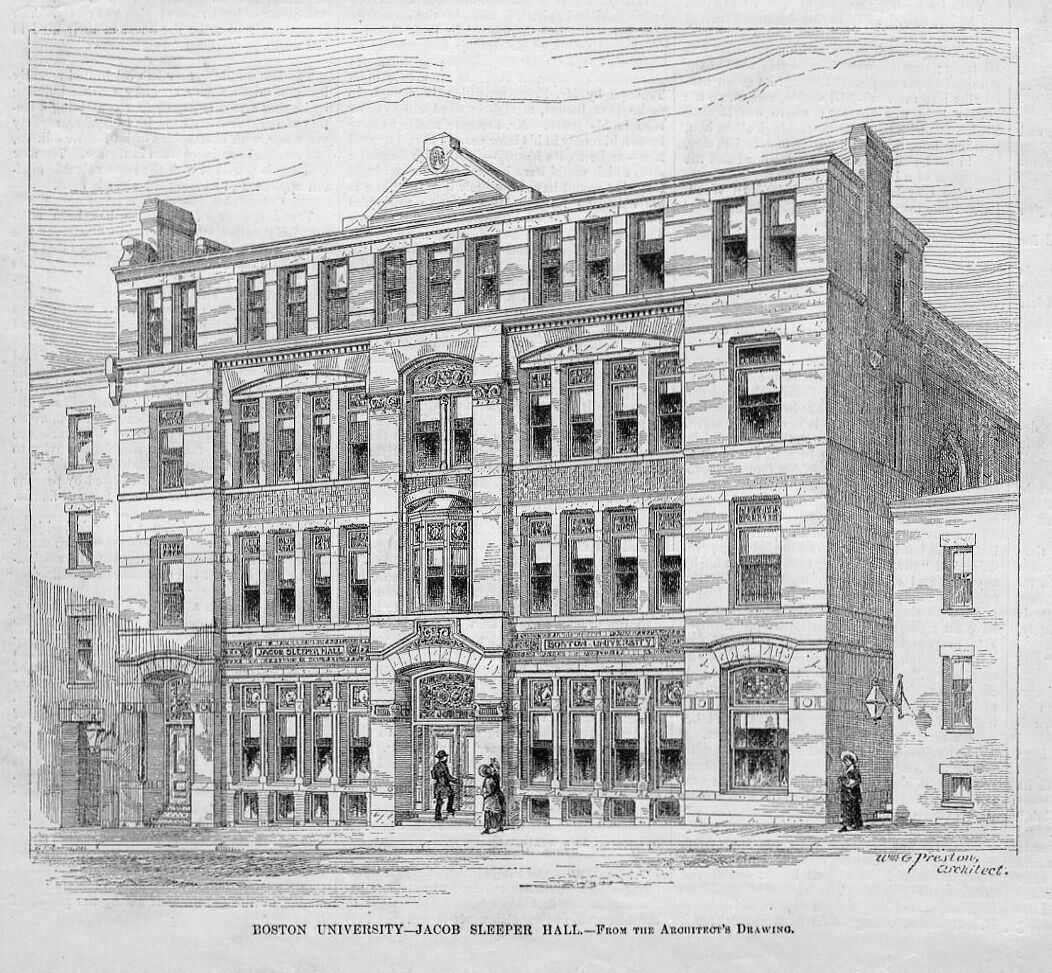
-
1882
William E. Huntington, Professor of Ethics and History, becomes the 2nd Dean of CLA. Huntington had earned his PhD from Boston University and had taught there for many years. Known for his gentle, compassionate personality, students called him “the dear Dean.” He would later serve as the 2nd President of Boston University.
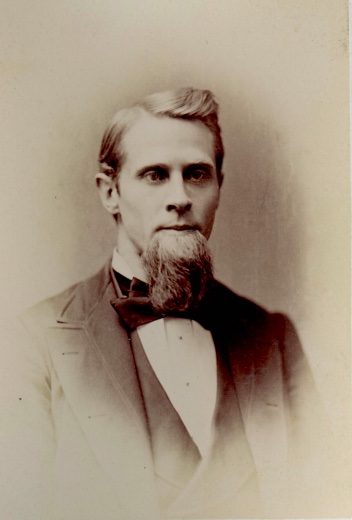
-
1882
The college hires its first scientist, astronomer Judson B. Coit, as an assistant professor of mathematics. Colt also teaches astronomy courses, and takes students out to observe the sky from the middle of Boston Common. He eventually becomes a professor of astronomy.
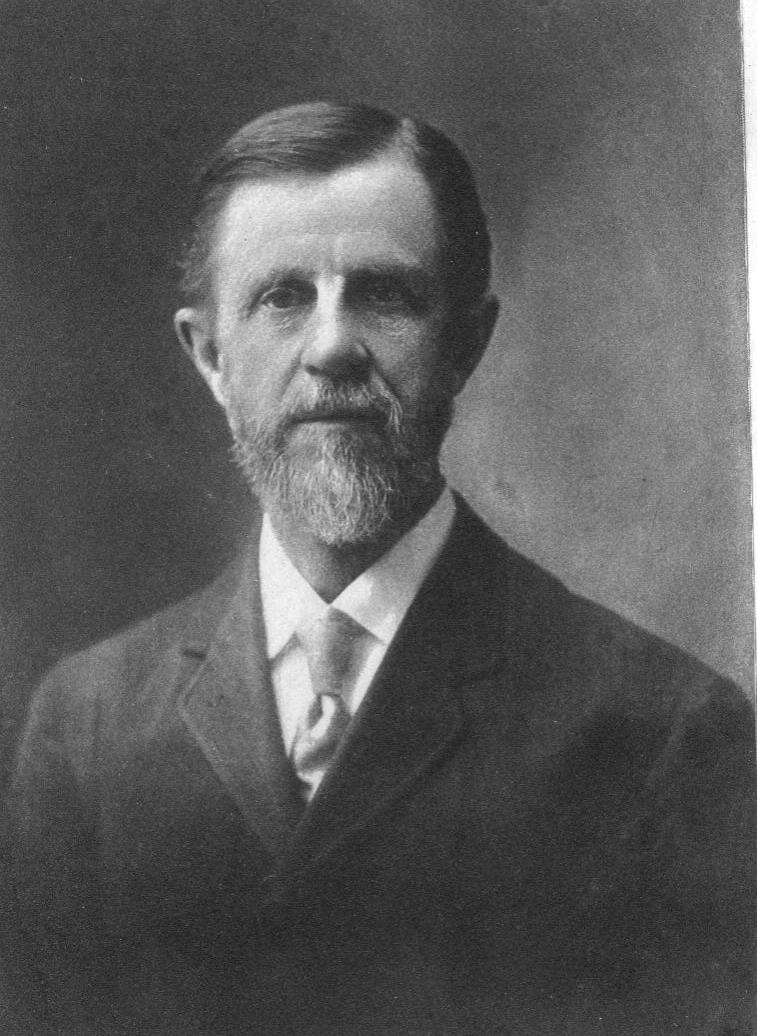
-
1883
Louisa Holman Richardson graduates from CLA. She later earned a Masters and Doctors degree from Boston University, won a Fellowship from the AAUW, and was the Dean of Women at Ohio Wesleyan University. After her marriage to Everett O. Fisk, she became a Trustee of Boston University and founded the BU Women’s Council.

-
1884
President William F. Warren is appointed acting dean of the School of All Sciences.President Warren's Speech "The Essential Idea of a College of Liberal Arts"
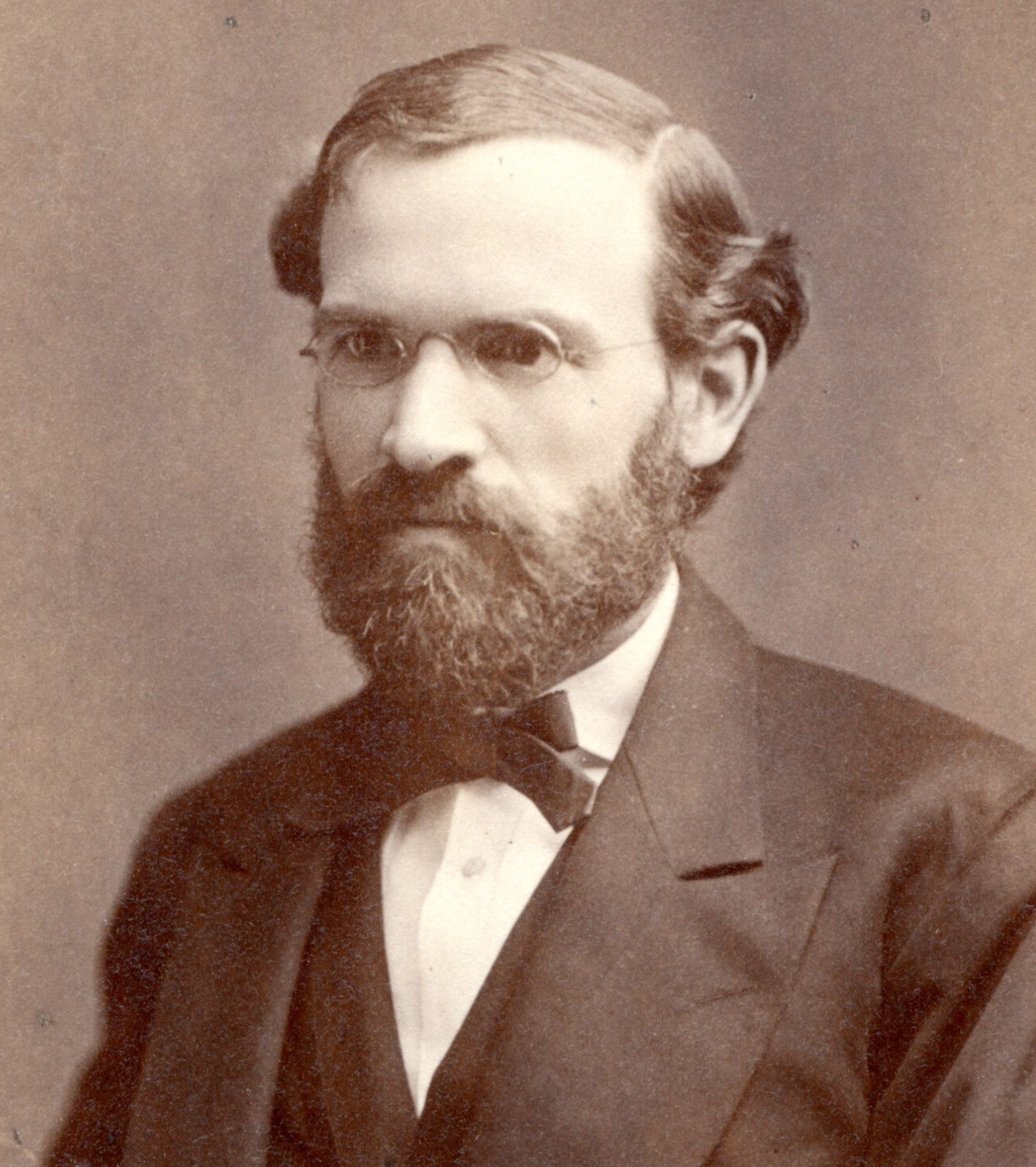
-
1886
John Calvin Ferguson graduates from Boston University’s College of Liberal Arts. Ferguson founded the original campus of Nanking University (1888-1897) as well as an early Western-style government college in Shanghai (1898-1902), the original campus of Shanghai Jiao Tong University today. Ferguson would later earn his Ph.D. from the School of All Sciences. A collector and dealer of Chinese art, he collected art for museums in the US 1910s, including the MET, NYC’s Knoedler Gallery, Philadelphia’s University Museum, the Detroit Museum of Art, and more.

-
1887
John Wesley Edward Bowen, a student of historical theology, Greek, and Latin, was the second person of African descent, and the first person born a slave, to earn a doctorate in the United States.

-
1887
James Geddes, Jr., becomes instructor in French, Italian, Portuguese, and Spanish. He also teaches a course in Phonetics. In the early-20th century, Geddes helps to spearhead a linguistic movement to create a universal alphabet for dictionaries of numerous languages, an apparent precursor to the international phonetic alphabet we know today.
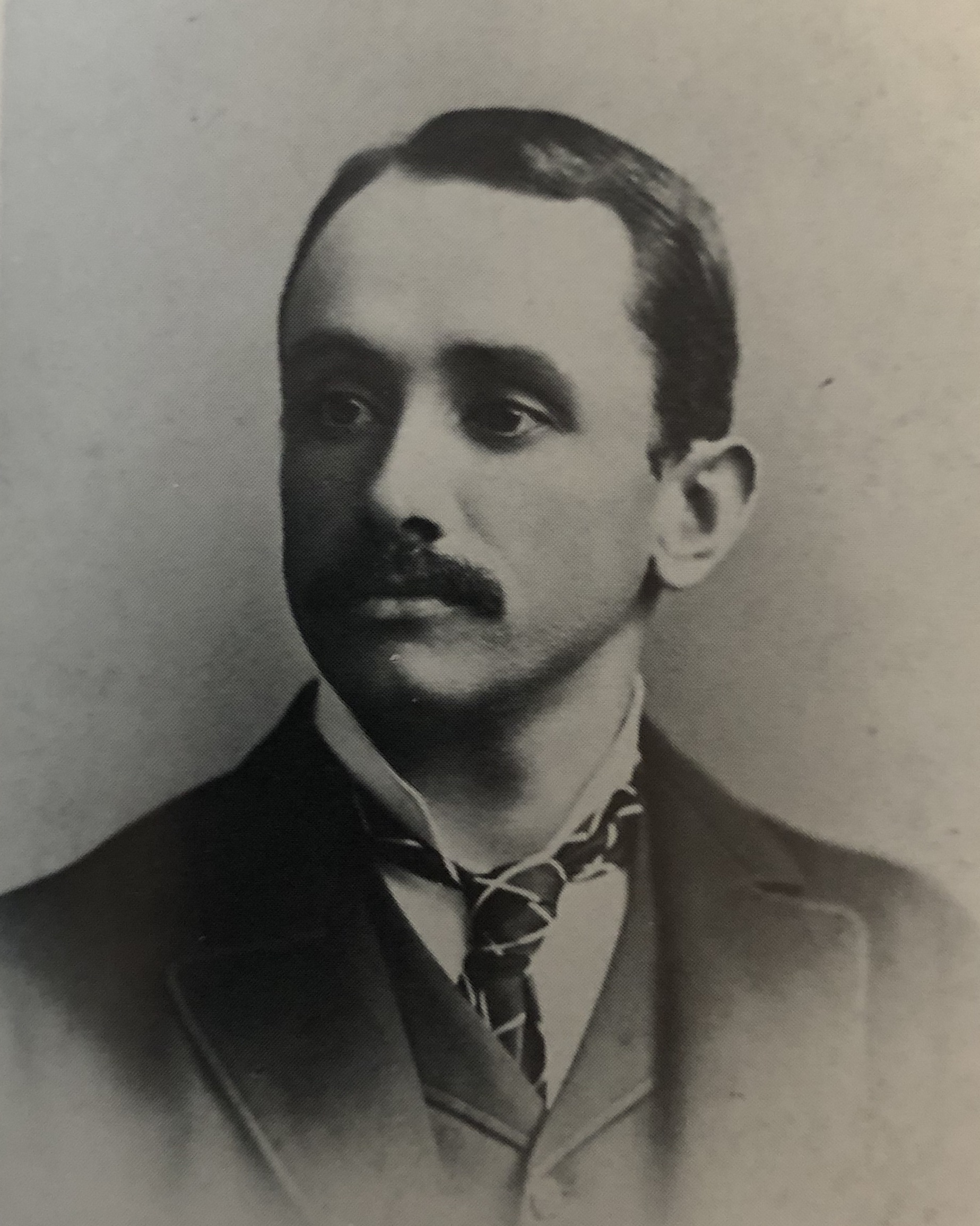
-
1887
William Marshall Warren, son of Harriet Merrick Warren and President William Fairfield Warren, graduates with a Bachelor of Arts degree. He would go on to earn his Ph.D. from the Graduate School in 1892. He served as a part-time instructor of rhetoric, english, history, and ethics in the late 1880s and then as a full-time faculty member of philosophy after earning his doctorate. His 33-year service as the third appointed Dean of the College of Liberal Arts began in 1904.

-
1887
Henry C. Sheldon, Professor of Systematic Theology, was appointed acting dean of the School of All Sciences.

-
1887
William Ellery Chenery graduates from CLA in 1887. He would go on to become a distinguished laryngologist, oral surgeon, and—later—a trustee for Boston University. In 1938, he purchased the Oak Ames estate at 225 Bay State Road, which Mr. Ames had purchased from William Lindsey. Better known as “the Castle” by the BU community, the estate features an ornate Gothic revival theme. Trustee Chenery insisted that the Castle serve as a home for presidents of Boston University, and he donated the estate to BU for that purpose. President Daniel L. Marsh and his family moved into the Castle later that fall. In the 1950s and 1960s, President Harold C. Case and his family lived in the Castle as well.

-
1888
Borden P. Bowne is appointed as the first dean of the School of All Sciences. He remained in the post until his death in 1910. Under Dean Bowne, the School of All Sciences was renamed the Graduate School of Arts and Sciences.
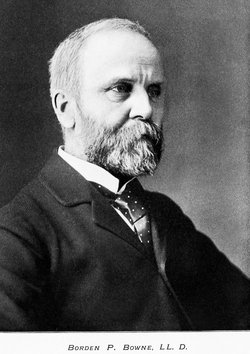
-
1889
The College’s course catalogue is classified into groups for the very first time “to facilitate insight into their vital unity and organic connections.” Groupings included: (1) Oriental Languages and Civilizations, (2) Languages, Literatures, and Civilization of Ancient Greece and Rome, (3) English Language, Literature and History, (4) Languages, Literature, and History of Modern Continental Europe, (5) Philosophy and Ethics, (6) History, (7) Economics, Law and Social Science, (8) Mathematics, Physics, and Astronomy, (9) Chemistry, Biology, and Geology, and (10) Life, Personal Development, Expression.
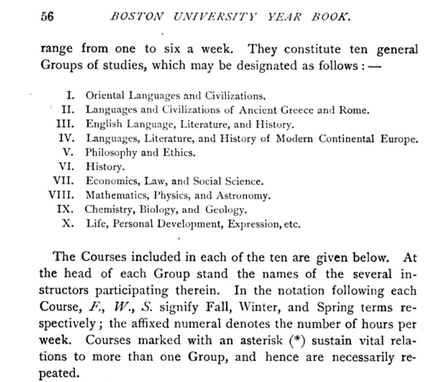
-
1889
Florence Louise Nichols earns Phi Beta Kappa honors and graduates with a Bachelor of Arts. In 1891, she receives her Master of Arts from the Graduate School. She later serves as the President of Isabella Thoburn College in Lucknow, India. She was, by 1926, among 32 BU graduates serving as college presidents, though the lone woman. Other CLA graduates presided over institutions such as New Orleans University, Central Normal College, and Rollins College.
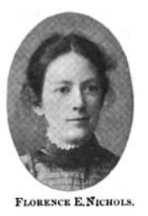
-
1890
Mary Simkhovitch graduates from CLA and becomes a pioneering city planner and social worker. She later becomes a founder of the Greenwich House, a settlement house in New York City that combats living and working conditions for the poor.
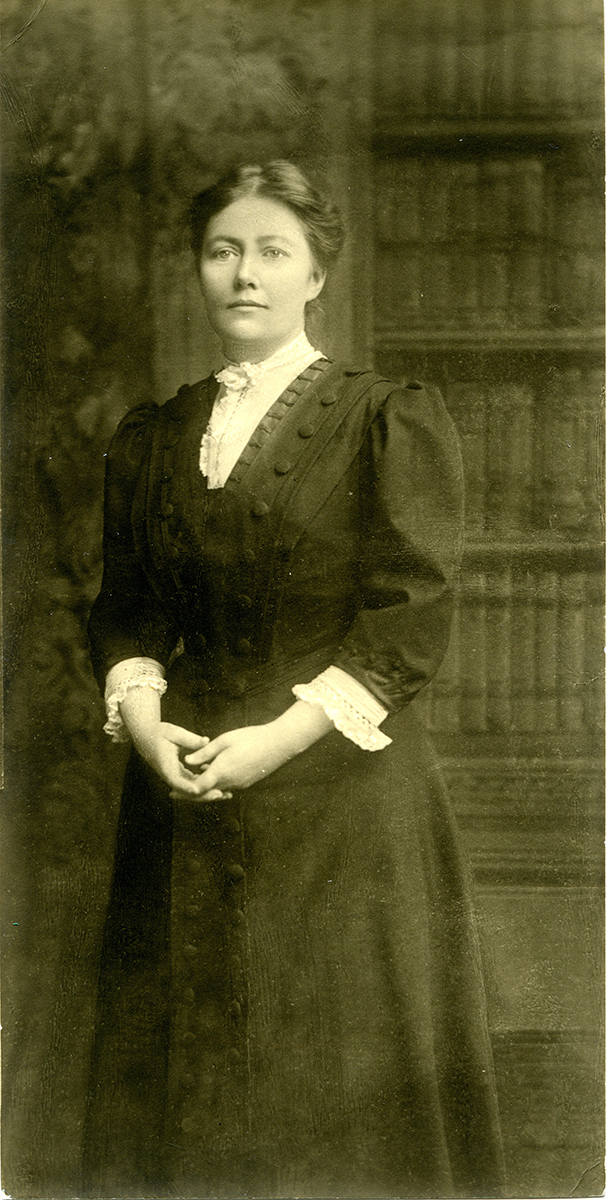
-
1890
As early as 1890, Dean William E. Huntington teaches a required, 1-credit course for first-year students entitled, “Collegiate Life and Work.” The course is taught by later Deans of the College up and through the late 1930s. When Dean Warren taught the course, it covered “the workings of the College; the history and organization of Boston University; the aims and methods of study; and the field of knowledge.”
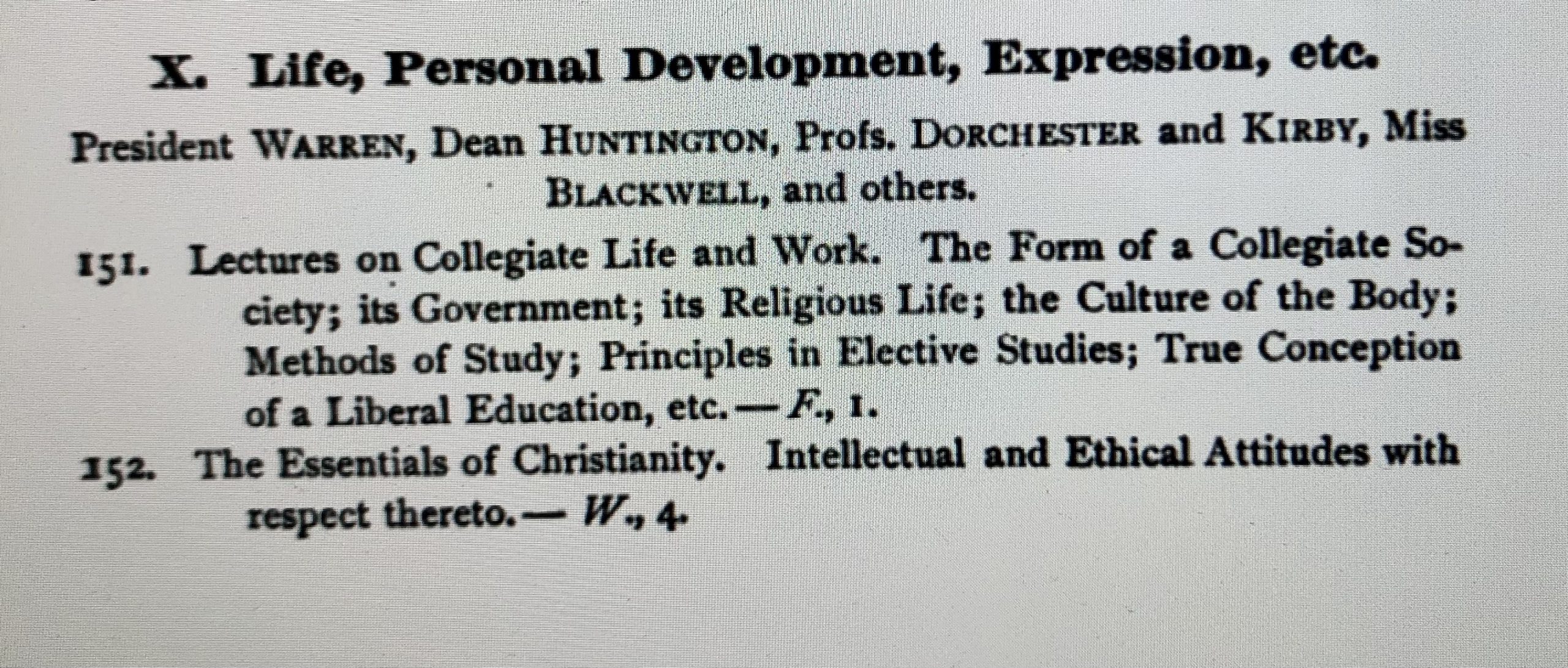
-
1891
The Class of 1891 creates a yell: “B.U. Boom la la! / Nonaginta Una! / Ya! Ya! Ya!”

-
1891
CLA separates classes into ten “groups of study,”’ a forerunner to the departments and programs we have today.

-
1892
284 out of the 938 students enrolled at Boston University are CLA students.
-
1895
Malvina M. Bennett, member of the second CLA Class of 1878, returns to CLA as its first full-time woman faculty member. One year later, she is promoted from Instructor to the Snow Professor of Elocution and Oratory.

-
1896
The Men’s Club of 1896 was founded “on account of the comparative weakness in numbers of the male contingent of the College of Liberal Arts.”

-
1899
Boston University’s Phi Beta Kappa chapter founded.
-
1903
A BU Beacon report states that although study in France would be good for students, most prefer to go to Germany because it is beneficial for their careers.

-
1903
BU hires Agnes Knox Black to serve as the next Snow Professor of Elocution and Oratory. Prof. Black graduated with her undergraduate degree from the University of Toronto then went on to graduate school for elocution in Philadelphia. Before BU, she worked at the University of Toronto, the University of Edinburgh, and Emerson College.

-
1904
William Marshall Warren begins his 33-year tenure as Dean of CLA.

-
1905
The College of Liberal Arts offers 13 courses of instruction: Oriental Languages; Greek Language and Literature; Latin Language and Literature; English Language and Literature; Romance Language and Literature; Germanic Language and Literature; Philosophy and Education; History; Economics, Social Science, and Law; Mathematics; Natural Sciences; Bible Study, Elocution, Lectures; Music.
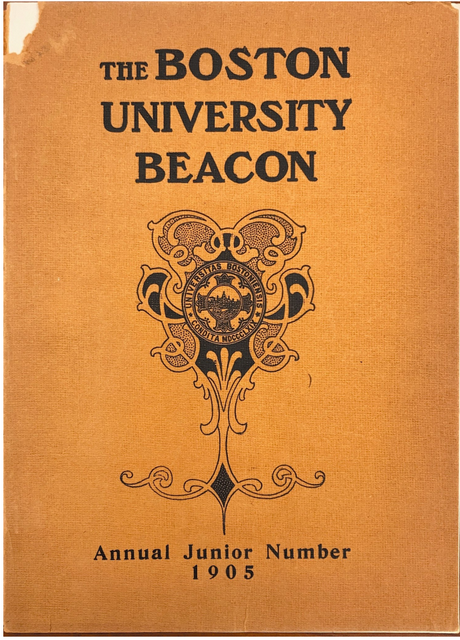
-
1906
Evening and Saturday classes for the instruction of teachers are established.

-
1907
Majors and Minors were introduced into the College’s curriculum for the first time as a counter-balance to free electives.
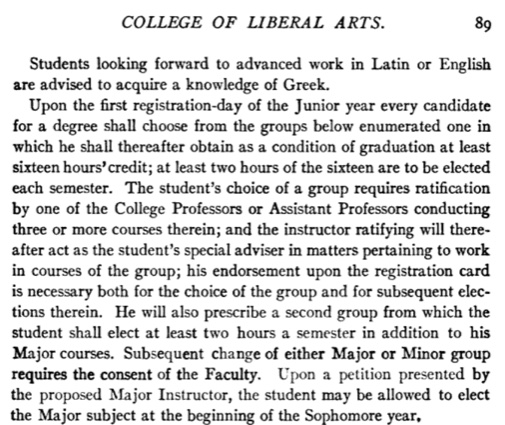
-
1907
CLA acquired the Harvard Medical School Building at 688 Boylston Street near the new Boston Public Library in Copley Square. The new quarters were considerably larger for a school that now enrolled over 500 students. It included larger classrooms and more space for a library and laboratories, especially for science departments (previously housed at MIT at 525 Boylston Street). The central foyer was paved with marble and featured large granite columns that supported the floors above; student referred to the space affectionately as “the Marble” and it became a gathering place for rallies, Christmas sings, and alumni reunions.
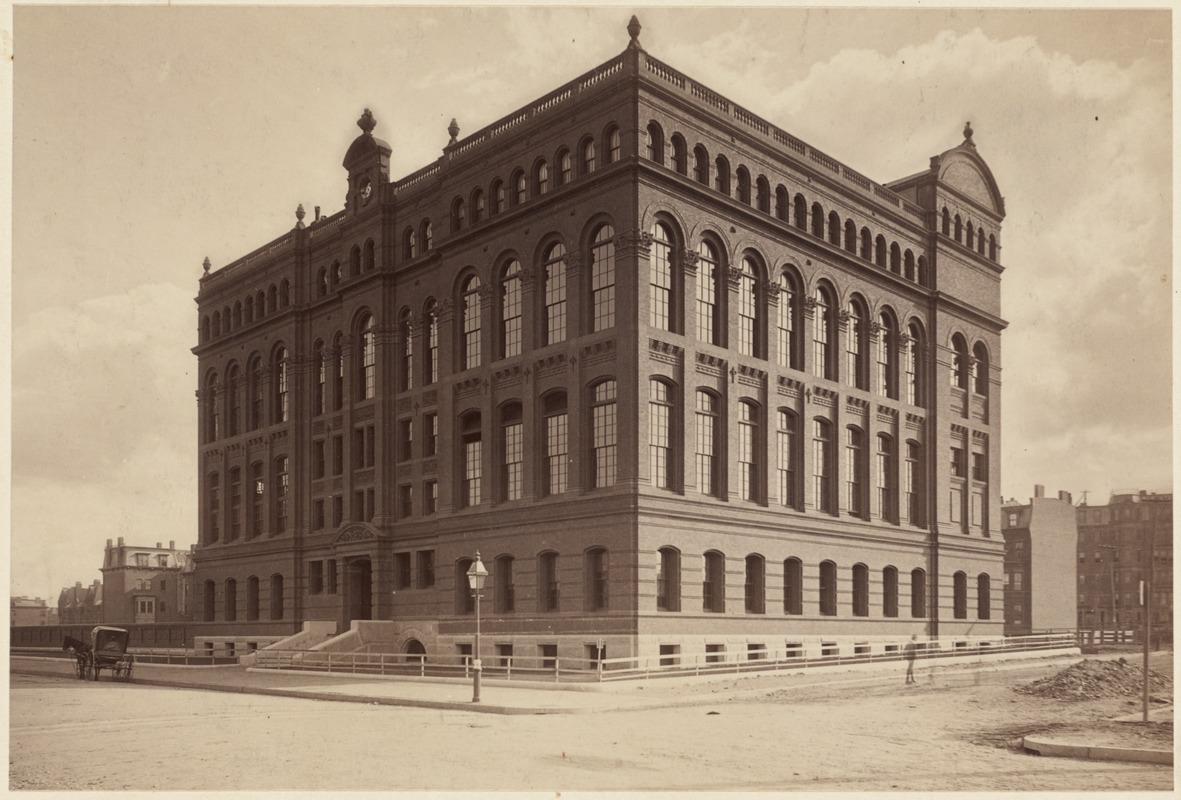
-
1908
A year later, an annex was constructed on the east side of “688” and named Jacob Sleeper Hall. It included a 700-seat Assembly Hall, a women’s study, and a large gymnasium with indoor track and swimming pool.

-
1910
The School of All Sciences is renamed the Graduate School. The matriculation fee is $10 for a master's degree and $25 for a PhD. William E. Huntington is also appointed dean of the Graduate School.
-
1910
Upon raising $400,000 in endowment, three professorships are created in College of Liberal Arts.
-
1910
The new position of Men’s Secretary is created with the intent to advance the interests of men in the College of Liberal Arts and to draw interest from prospective students. Everett Lord, AB 1900, AM 1906, is the first incumbent.
-
1910
HUB Editor-in-Chief Emily Donnell Lord writes, “Unique among New England colleges is the personal interest that the Boston University professor has in his students.” She claims that BU faculty talk things over with students and actually enjoy class time.
-
1911
After serving as BU’s second president for seven years, William E. Huntington (GRS 1882) steps down from that post to serve as the second dean of the Graduate School of Arts & Sciences (GRS, previously the School of All Sciences). The matriculation fee at GRS is $10 for a master's degree and $25 for a doctoral degree.

-
1911
Judson Coit is appointed as acting dean of the Graduate School.
-
1911
Jennie Loitman Barron graduates with a Bachelor of Arts. She goes on to be an American suffragist, lawyer, and judge. She is the first woman judge appointed for life to the Municipal Court in Boston (1937), and the first woman appointed to the Massachusetts Superior Court (1959).

-
1913
The College of Liberal Arts Department of Education is founded. A majority of CLA graduates go into teaching.

-
1913
The College of Business Administration (later the School of Management, later the Questrom School of Business) is established as a separate school with Everett Lord as the first dean. The idea for a separate school first emerged as part of the plan to encourage more men to attend BU.
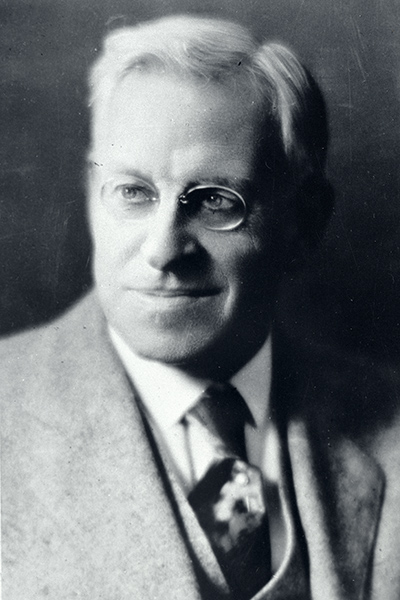
-
1914
After discussion of a need for a dean/advisor of women, Agnes Black, professor of elocution, is appointed Advisor of Women.
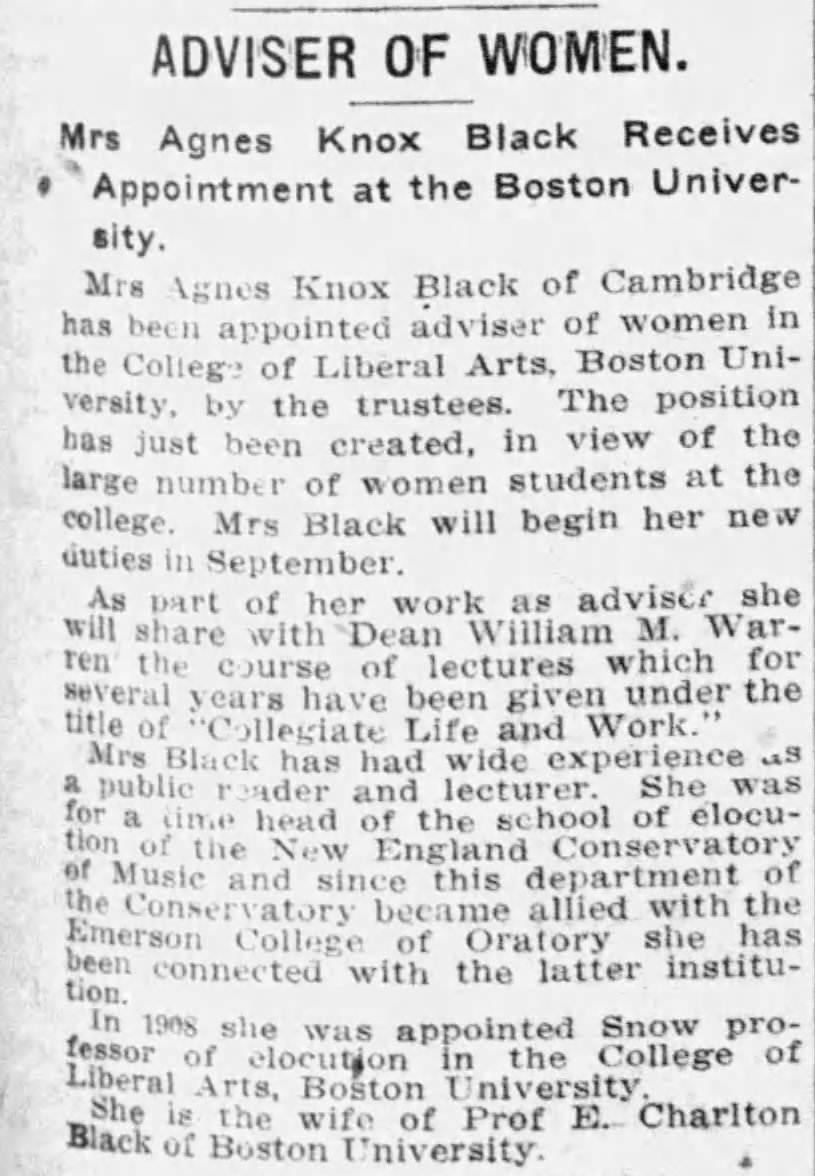
-
1917
Helen Stevens (CLA 1905) is hired to provide instructional support to the ever-expanding academic unit in Chemistry. She is later named Associate Instructor.

-
1917
Degree requirements are revised to include the first semblance of a distribution requirement since, in addition to a Major and Minor, students were also required to elect 10 hours of coursework from each of six groups: (1) Economics, Eduction, (2) English, Language and Literature, Public Speaking, Music, Art, (3) Foreign Languages, (4) History and Social Science, (5) Mathematics and Philosophy, and (6) Natural Sciences.
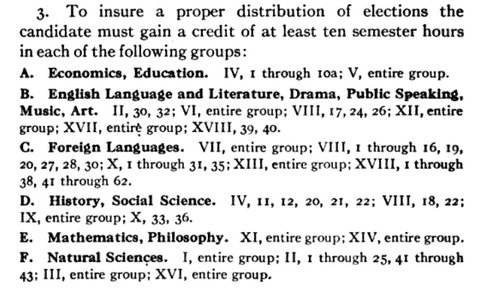
-
1918
World War I: CLA is very involved in war work. It provides training for women to become sick room assistants, has groups of students working with faculty volunteers to study issues related to the war; offers a course on Red Cross work; collects books for soldiers; women students knit sweaters for soldiers. CLA student council passes resolutions condemning Germany and support President Wilson.
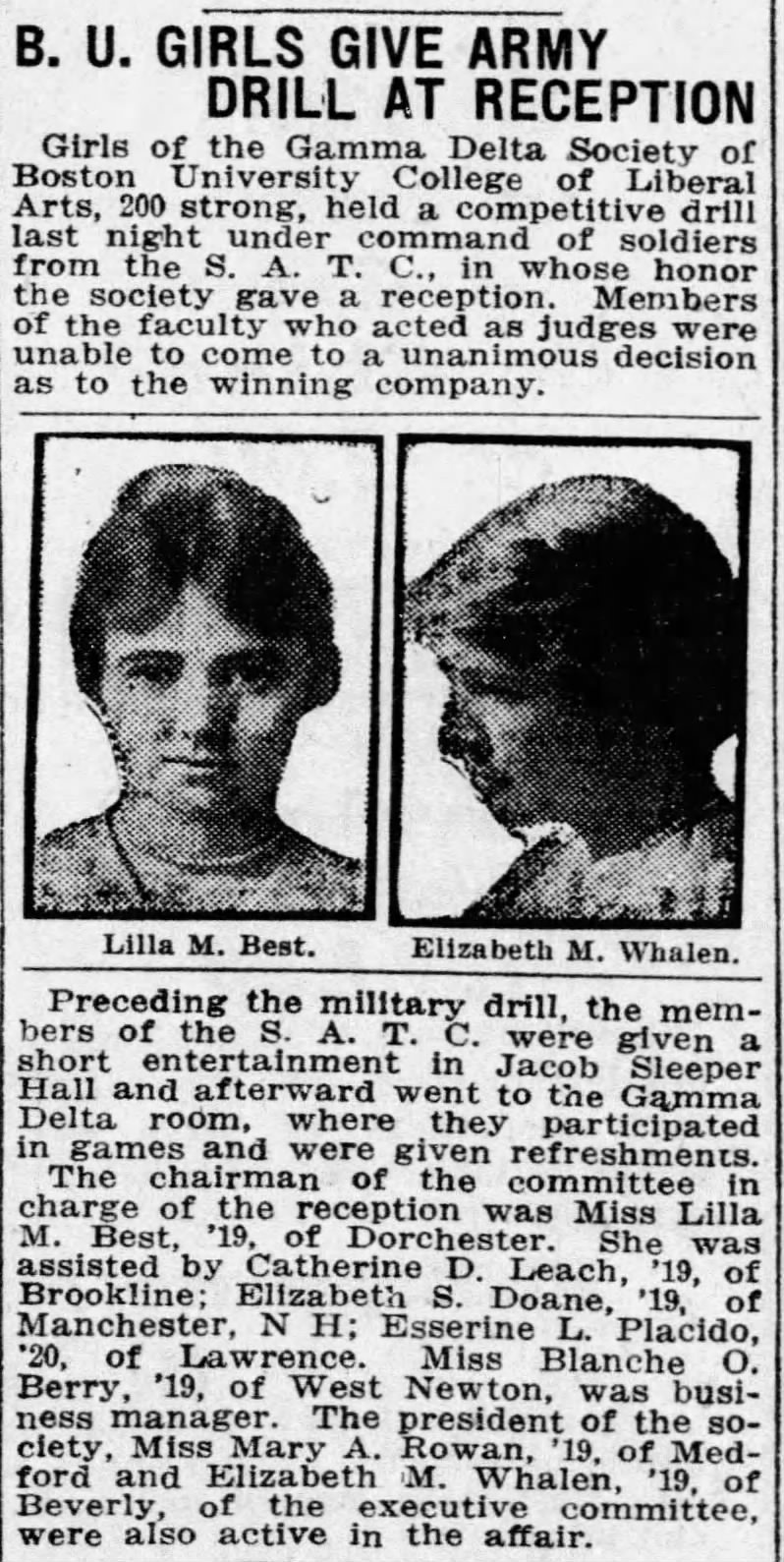
-
1918
Priscilla Fairfield graduates from CLA. While still a student, she publishes her first scientific paper, “Observations of sunspots at Boston University.” Later, She and her husband Bart Bok publish a textbook called The Milky Way, coining the popular term ‘milky way’ that we use today.

-
1918
The 1918 flu pandemic was full blown by fall and Boston University was forced to postpone registration four times. CLA faculty resorted to sending reading assignments by postal mail. Class finally began in late October on an abbreviated 12-week schedule.

-
1920
CLA freshman wear red caps or braids with red ribbons as part of a “hazing” tradition.
-
1921
Willis Jefferson King earns his Ph.D. in sociology from the graduate school. He later represents the World’s Student and Christian Federation in Peking, China, and also serves as a Fellow of the Julius Rosenwald Fund for Research at Oxford University. He goes on to serve as President of Samuel Huston College (1930-1932) and President of Gammon Theological Seminary (1932-1944). He would end his career as an African-American Methodist bishop for Louisiana and Texas. Boston University awarded him an honorary Doctor of Divinity in 1933.

-
1922
An annual "Stunt Night" is held by CLA sororities on March 17th and men are invited for the first time. There is a performance of "Nevertheless," a hypnotist. a fortune teller, and an impression of a circus barker.
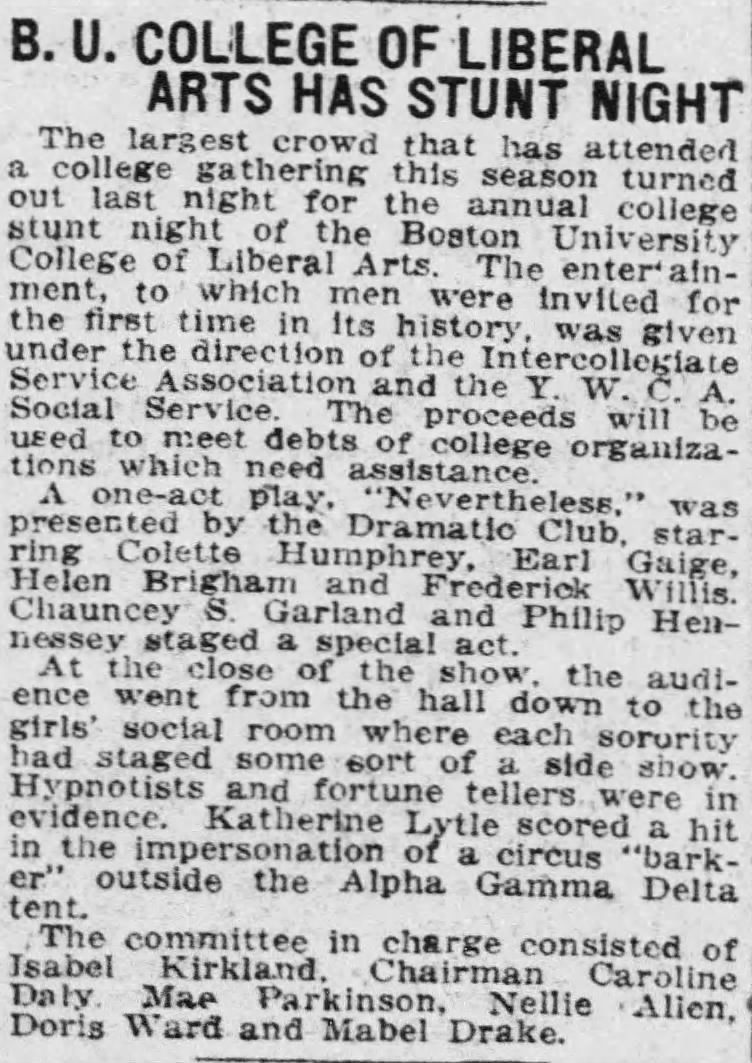
-
1923
CLA celebrates its 50th anniversary and President Murin gives an address that proudly details the accomplishments of women at BU.

-
1923
Waitstill Hastings Sharp from Hingham, Massachusetts, graduates from CLA where he studied Economics and English. Sharp is a Fellow of The Professor Augustus Howe Buck Educational Fund, which provided scholarships to students “of unusual promise, but with insufficient means, to receive a very much more thorough education than they could otherwise obtain.” Sharp went on to earn graduate degrees at Harvard and became a Unitarian minister. He and his wife, Martha, dedicated their lives to saving scores of threatened Jews and refugees fleeing Nazi occupation across Europe, and were honored among only a handful of gentiles in Yad Vashem’s list of “The Righteous Among the Nations.” His story has been immortalized in Ken Burns’ PBS documentary, Defying the Nazis: The Sharps’ War.
